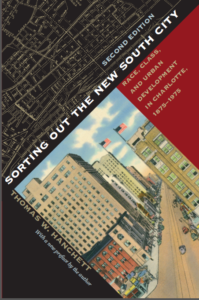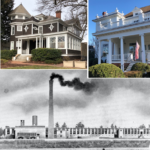 Today South End is a booming growth hotspot. But explore on foot and you’ll discover its historic roots as part of Dilworth, the city’s first streetcar suburb.
Today South End is a booming growth hotspot. But explore on foot and you’ll discover its historic roots as part of Dilworth, the city’s first streetcar suburb.
Edward Dilworth Latta hired famous inventor Thomas Edison to build Charlotte’s streetcar system. In 1891 Latta began selling lots in Dilworth — both for homes and also for factories, many affiliated with textile engineer D.A. Tompkins.
What’s to see? 14 officially-designated landmarks — century-old houses and textile-related factories rehabbed for fresh uses; Billy Graham’s boyhood church; the plant where Lance baked its famous neon-orange crackers. Mid-tour you’ll explore a couple blocks of the Dilworth Historic District. At the end, follow the “rail trail” along the LYNX light rail line.
If you like, pause for a drink or snack at any one of nearly 100 spots ranging from old-school Price’s Chicken Coop to new Jeni’s Splendid Ice Creams.
Where to start? Arriving by LYNX, disembark at the East-West Station. Coming by car, find street parking in the 1700-1900 blocks of Camden Road. Please help our shopkeepers — don’t park in a business’s lot unless you are buying something there.
How long? Just under 3 miles. If you are a brisk walker, that’s maybe 90 minutes. If you stroll, amble or dawdle (all are much encouraged), it’ll take longer.
Begin by walking outbound on Camden Road. (LYNX tracks will be on your left).
Live-work row – 1800 Camden Road, units 100 – 109
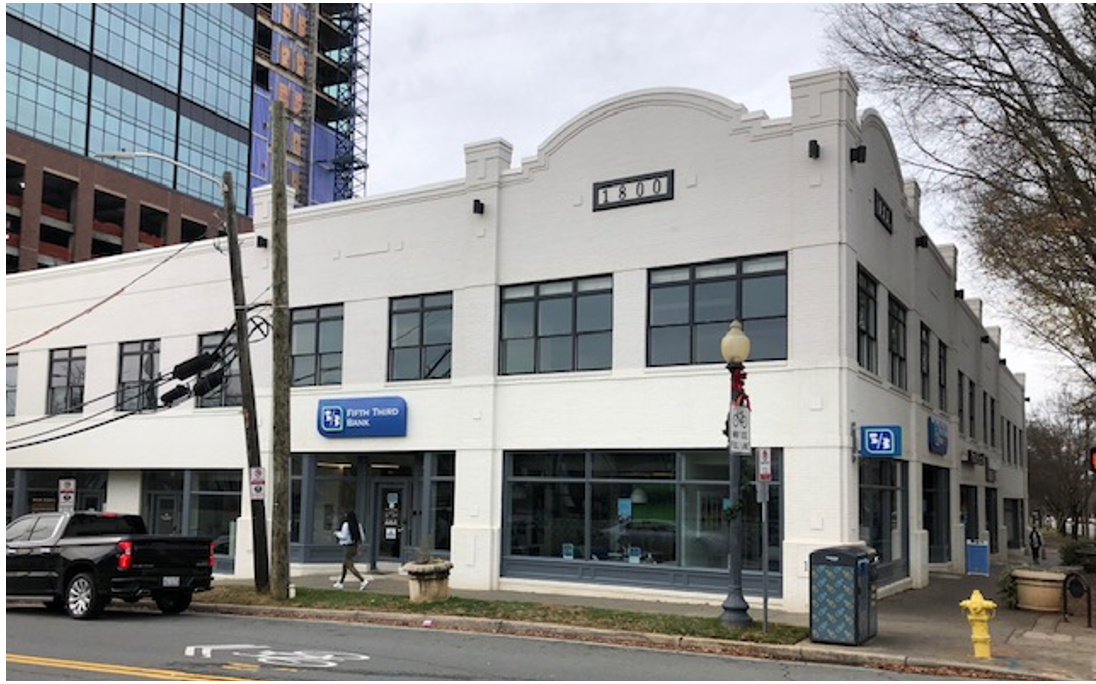
Lowes Tower – 1850 Camden Road
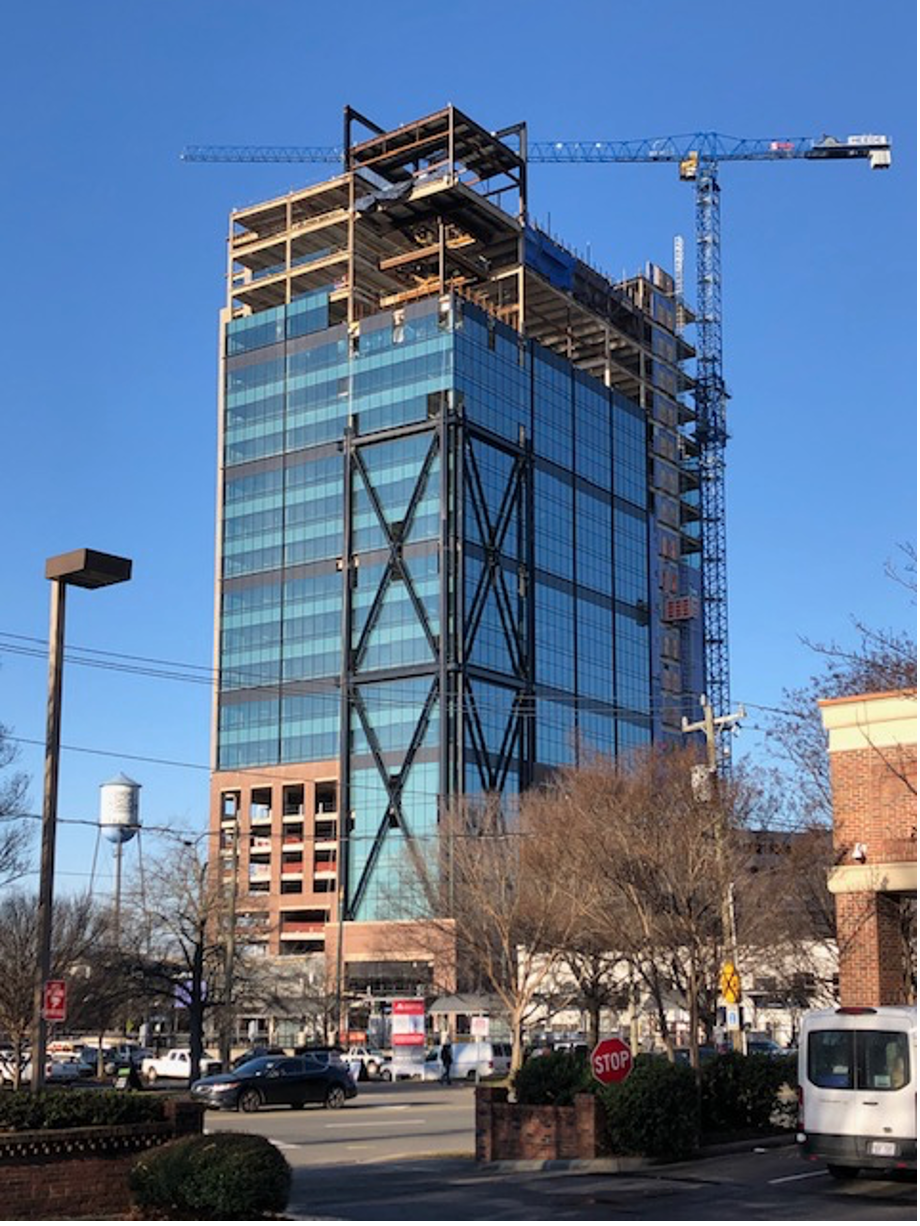
Nebel Knitting -- 101 W. Worthington Avenue at Camden Road
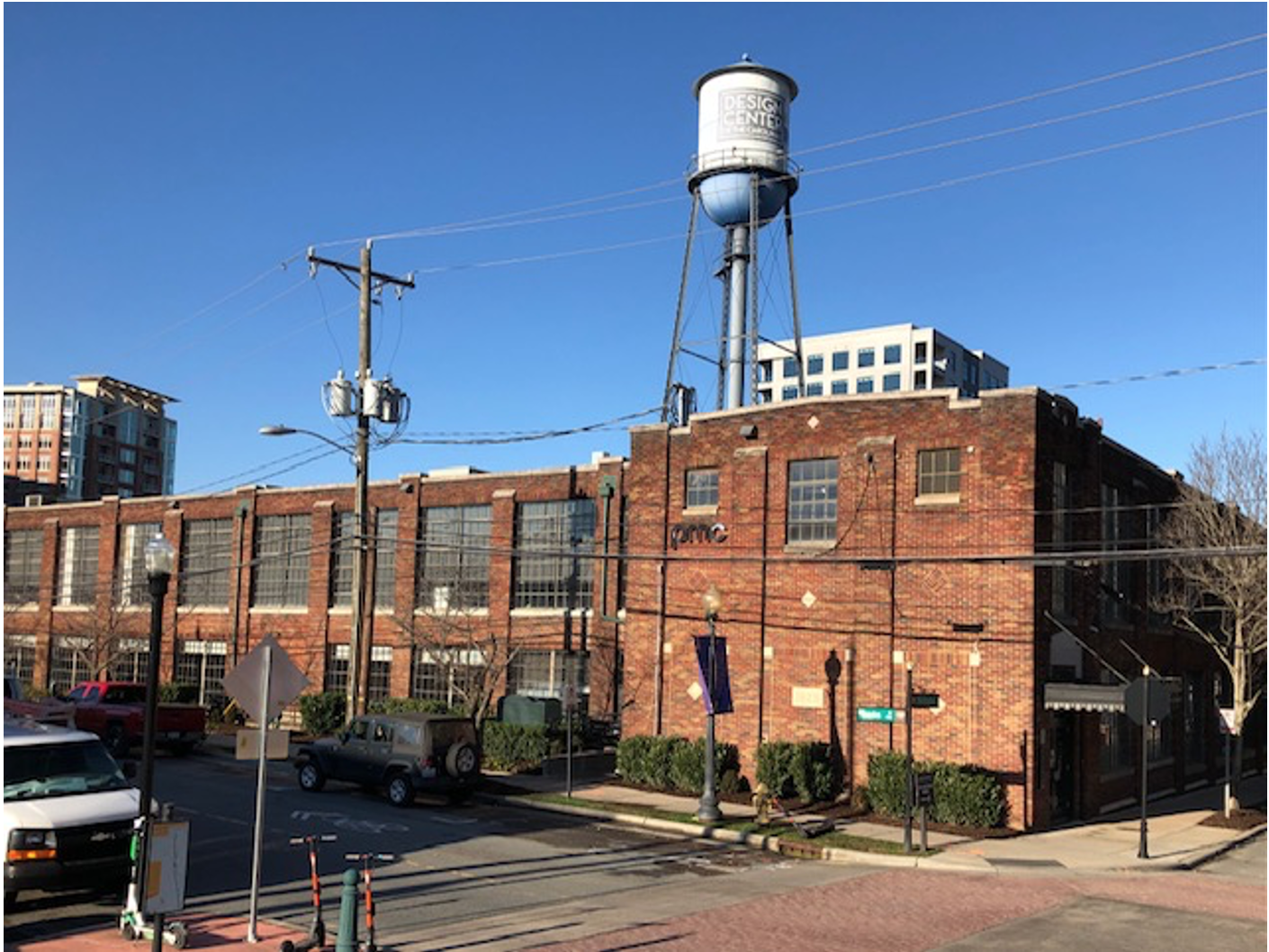
Question: If the Animaniacs ever left the cartoon world for CLT, would they live in the Nebel water tower?
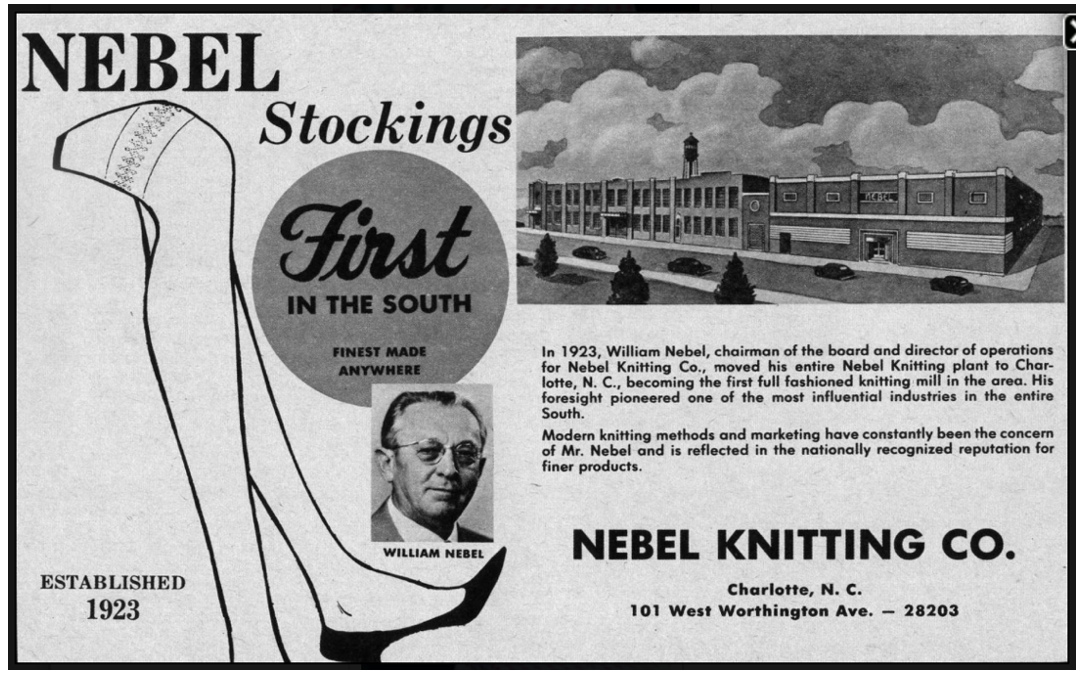
Nebel Knitting is an official Charlotte Mecklenburg Historic Landmark.
Jeni’s Splendid Ice Creams – 1920 Camden Road
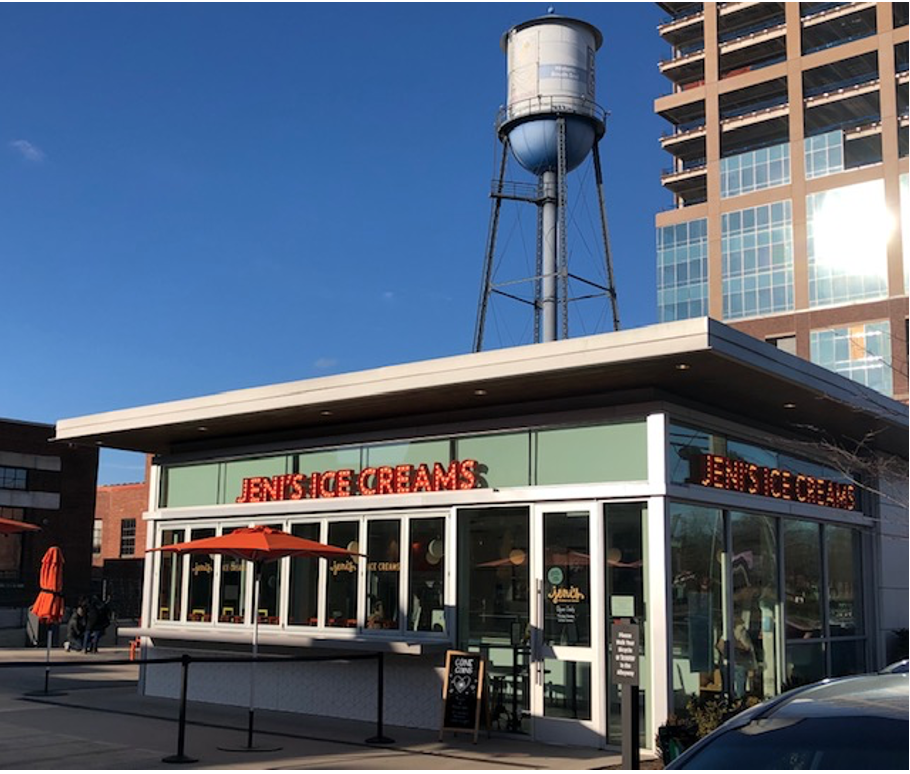
Left on Tremont, crossing the LYNX rails. Just past the tracks, turn right on the sidewalk along the LYNX line.
Parks-Cramer factory — 2000 South Boulevard
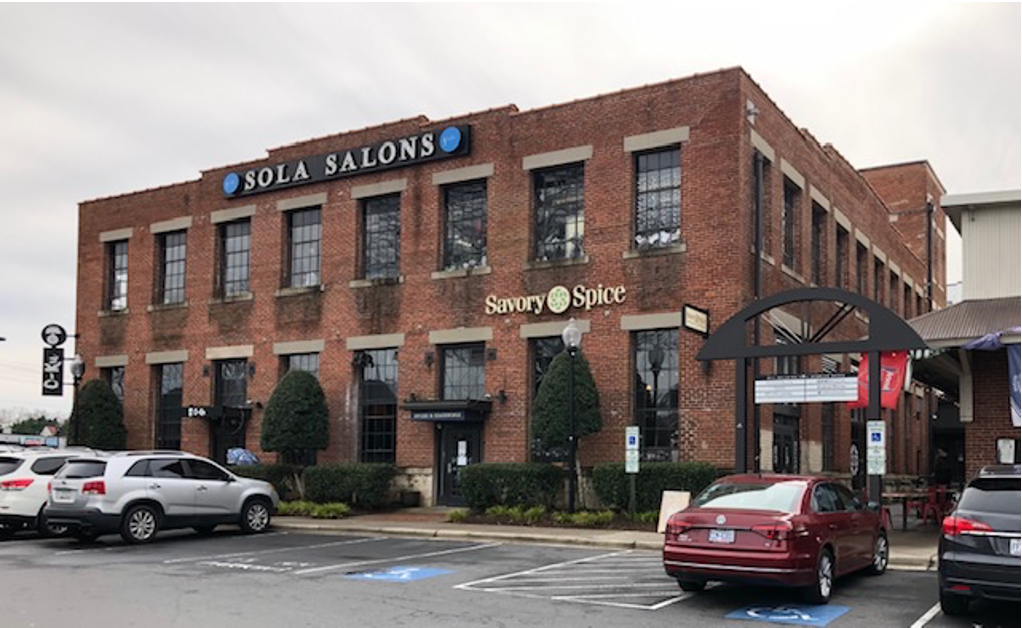
Can you imagine today’s South without air conditioning? Engineer Stuart Cramer invented gizmos to pump mist into the air of textile mills – which controlled both humidity and temperature. His April 18, 1906 patent for “air conditioning” was the first time that term was ever used at the US Patent Office. The aim wasn’t workers’ comfort, by the way. Cotton is easier to process in a warm, humid environment.
Parks-Cramer is an official Charlotte Mecklenburg Historic Landmark.
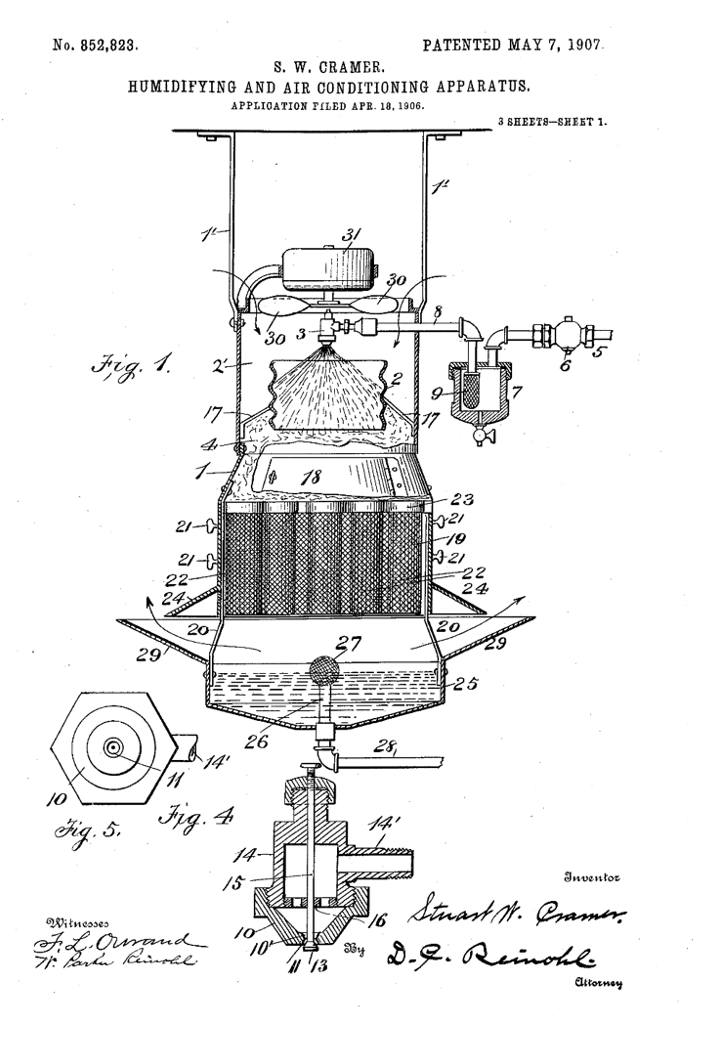
Continue along the sidewalk, keeping close to the LYNX track. A parking lot will appear on your left, then a new white-colored apartment tower with Indaco Italian Restaurant.
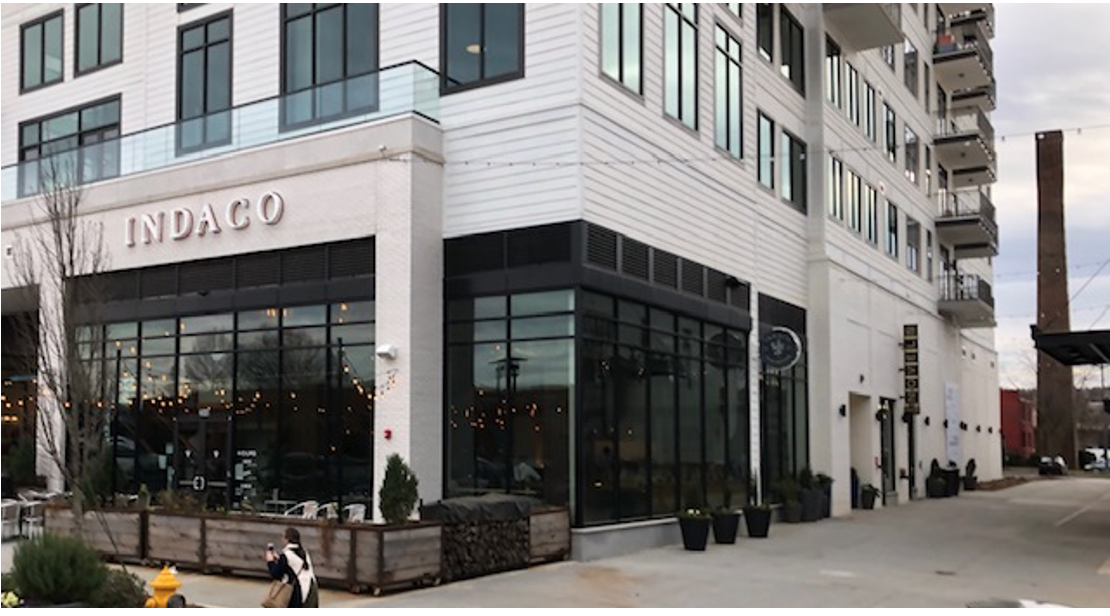
The Atherton Mill is a red brick building with a tall, square brick smokestack. See it, down the sidewalk that runs next to Indaco? OK, now walk down that sidewalk, then bear right along the LYNX track. Once you’ve admired the old mill, walk back the way you came, to Indaco.
Atherton Mill -- 2108 South Boulevard
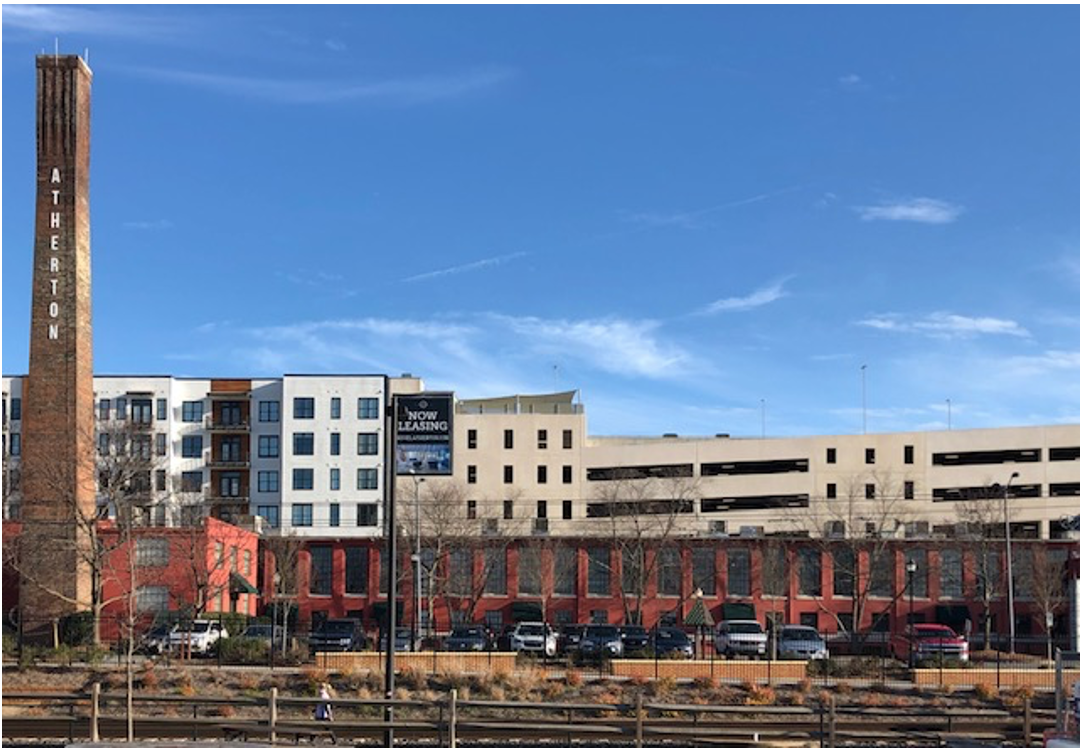
D.A. Tompkins, engineer by training and promoter at heart, built dozens of Carolina cotton mills, including the 1891 Atherton out beyond what was then the edge of Charlotte. Tompkins launched the daily Charlotte Observer and published books to ballyhoo his vision of an urban, industrial “New South.”
Columbia, South Carolina, developer EDENS recently completed the big apartment and retail structures adjacent to the historic factory. Atherton Mill is an official Charlotte Mecklenburg Historic Landmark.
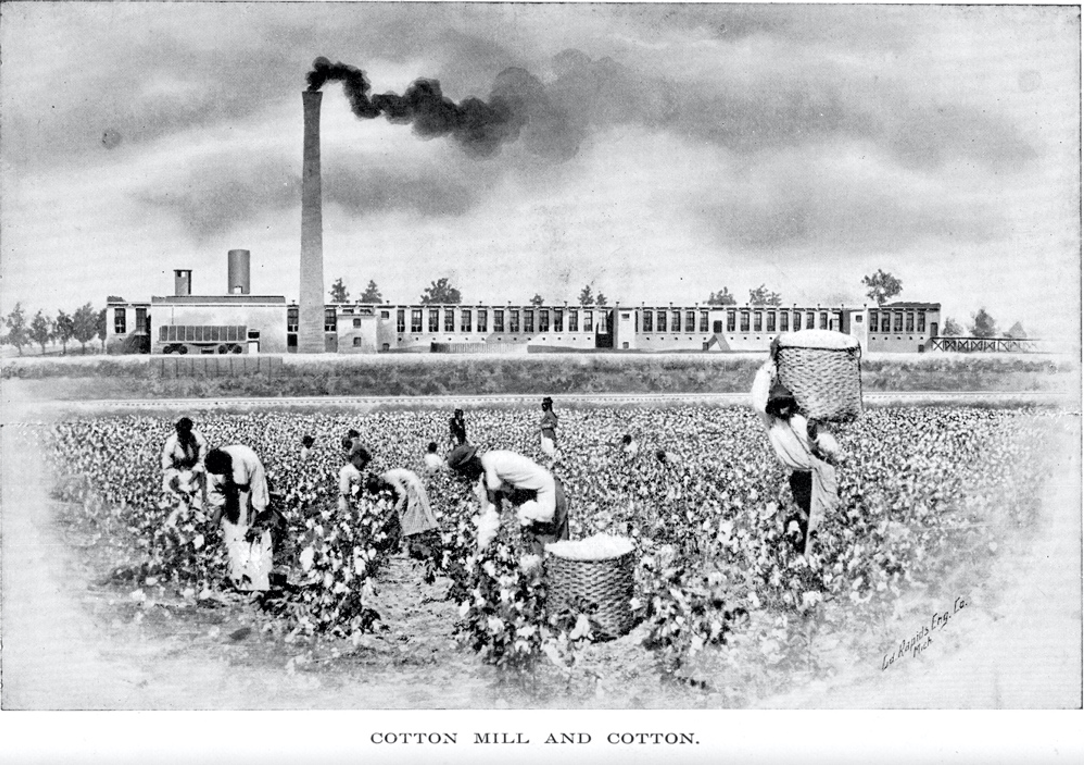
At Indaco, walk along the new upscale shops (Lulumon, etc.) to South Boulevard. Turn left on South Boulevard (inbound). (Parks-Cramer is now on your left)
At Tremont Avenue, use the traffic signal to cross busy South Boulevard. That will put you on South Boulevard’s right sidewalk, continuing in-bound.
Trolley’s End sign – 1933 South Boulevard
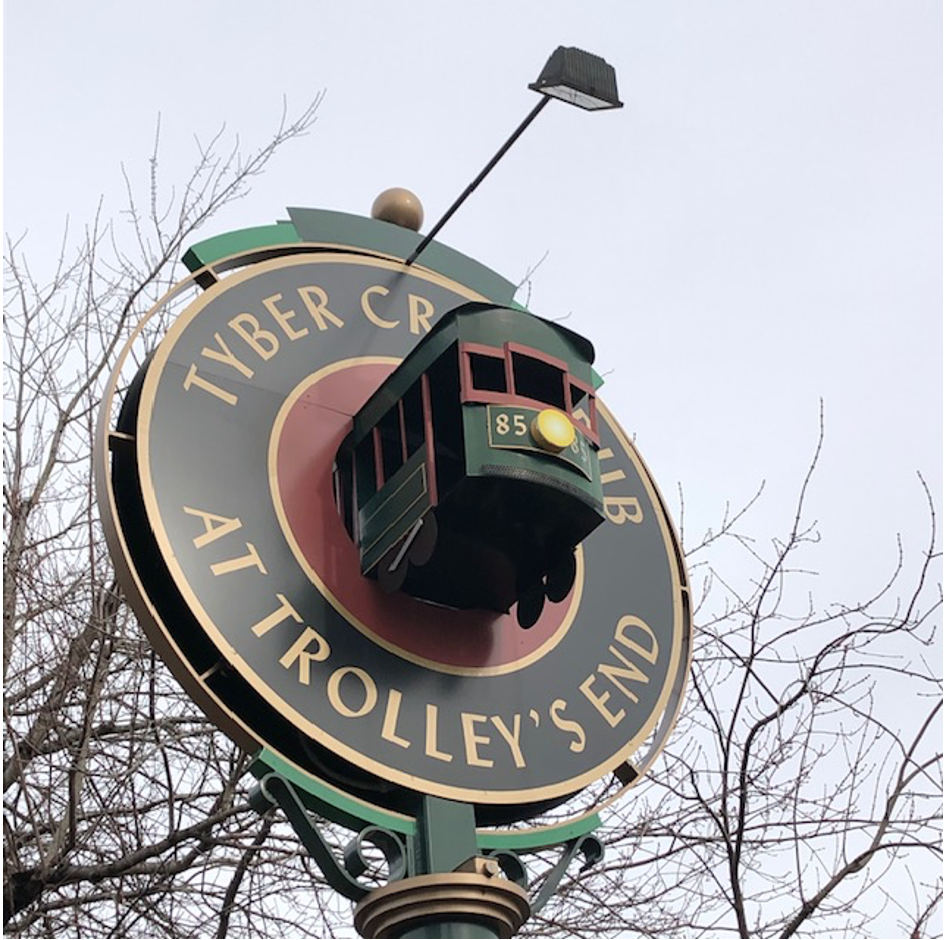
Leeper & Wyatt Store Building – 1923 South Boulevard
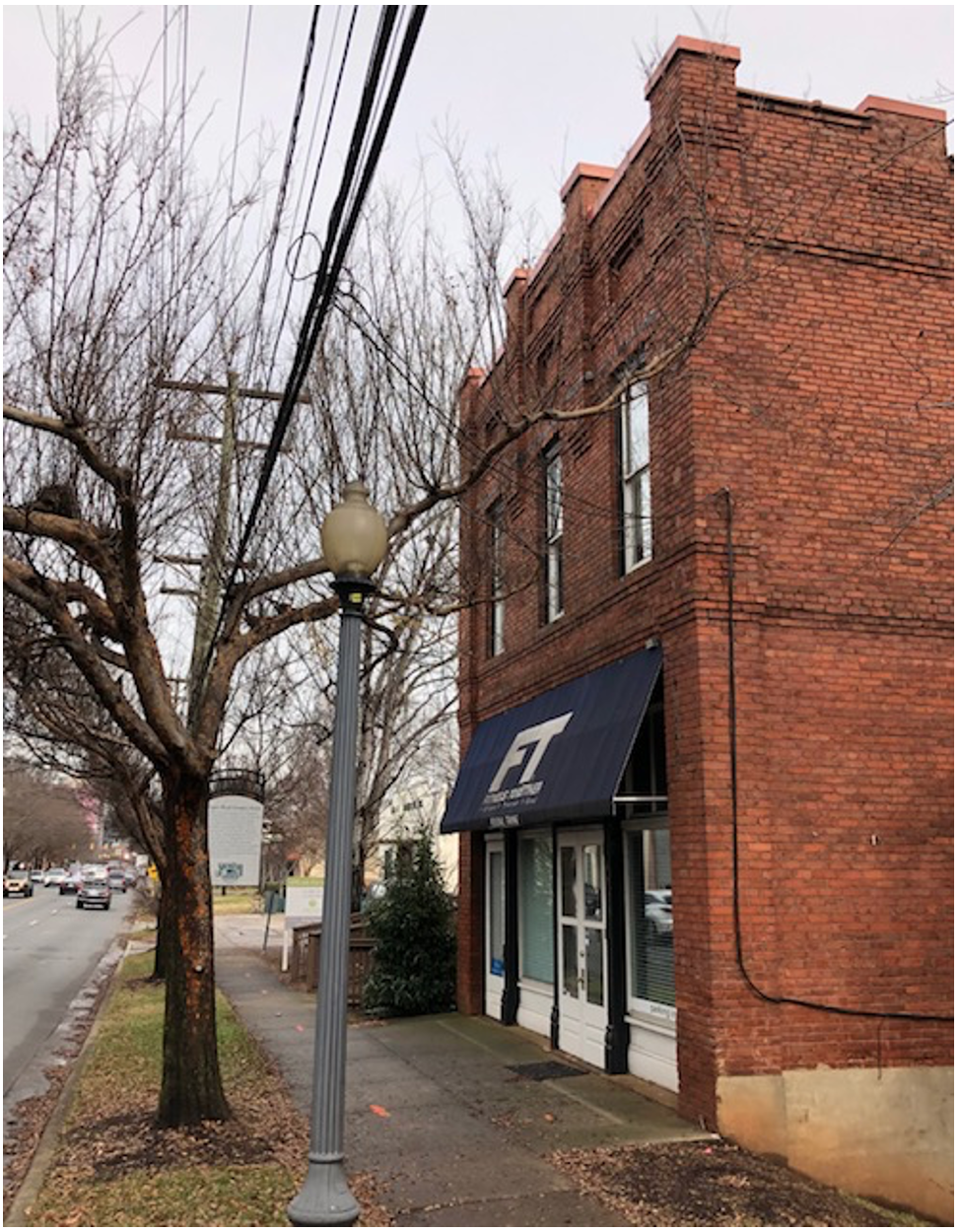
Leeper & Wyatt is an official Charlotte Mecklenburg Historic Landmark.
Tompkins Toolworks -- 1900 South Boulevard
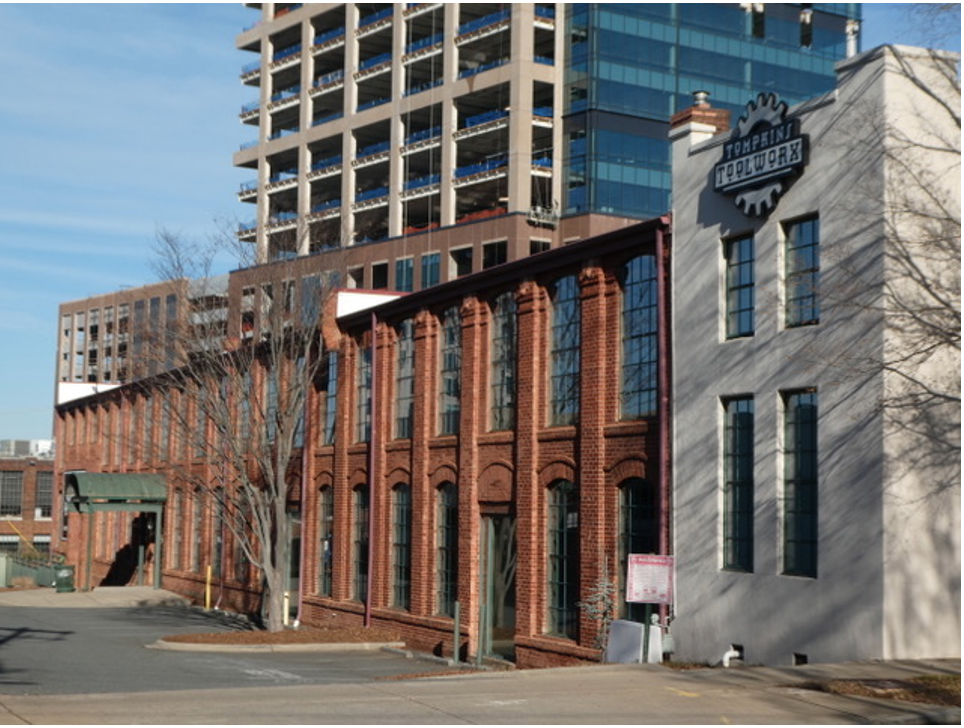
Renovated for offices in 2000, Tompkins Toolworks is an official Charlotte Mecklenburg Historic Landmark.
H & H Automotive – 1909 South Boulevard
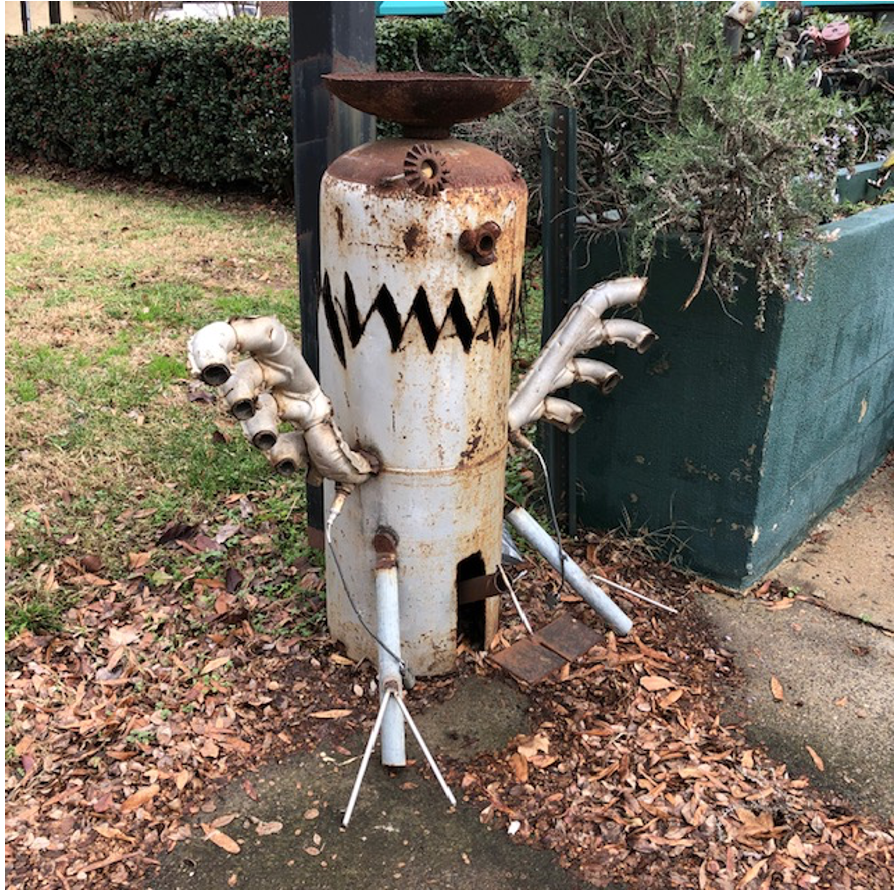
Whimsical car-parts sculptures are the signature of this establishment, little changed since the 1950s. Tony Honey started the garage in 1940, then moved to this spot with Peter Harakas in 1955.
Billy Graham’s boyhood church – 1800 South Boulevard
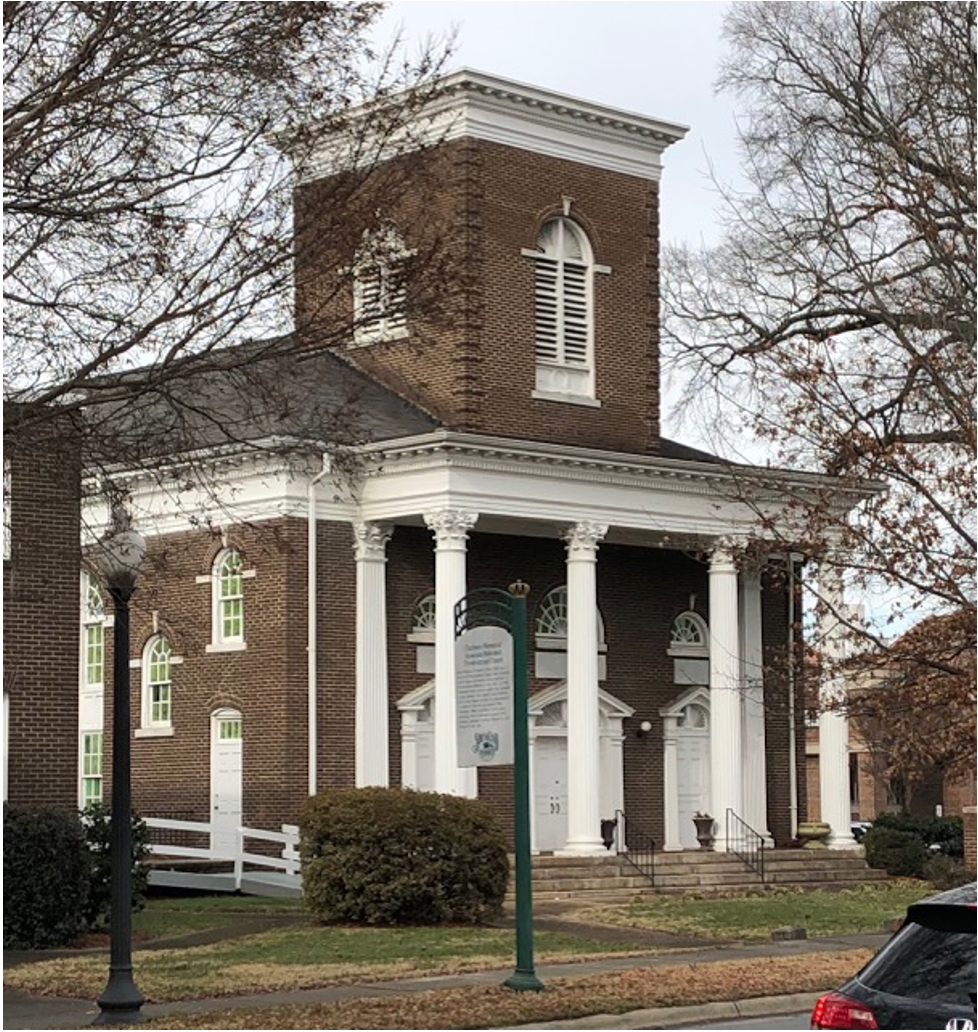
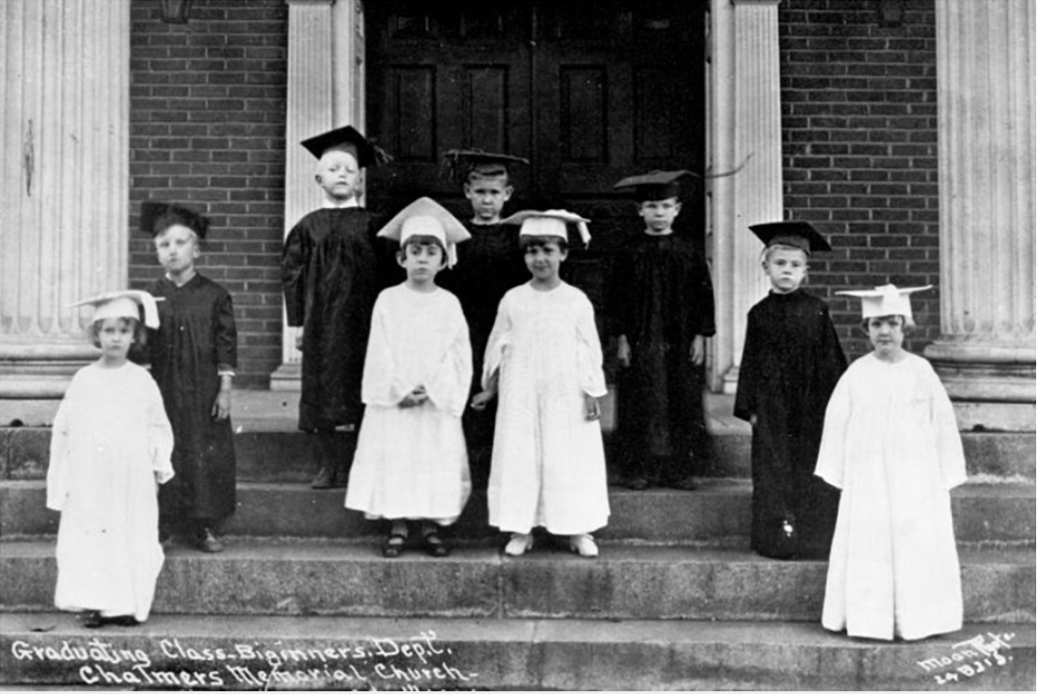
Five-year-old Billy Graham, second from left, graduates from the beginners department at Chalmers Memorial in 1924. Courtesy of BillyGraham.org.
Turn right on East Boulevard and take the right-hand sidewalk.
Dilworth Historic District
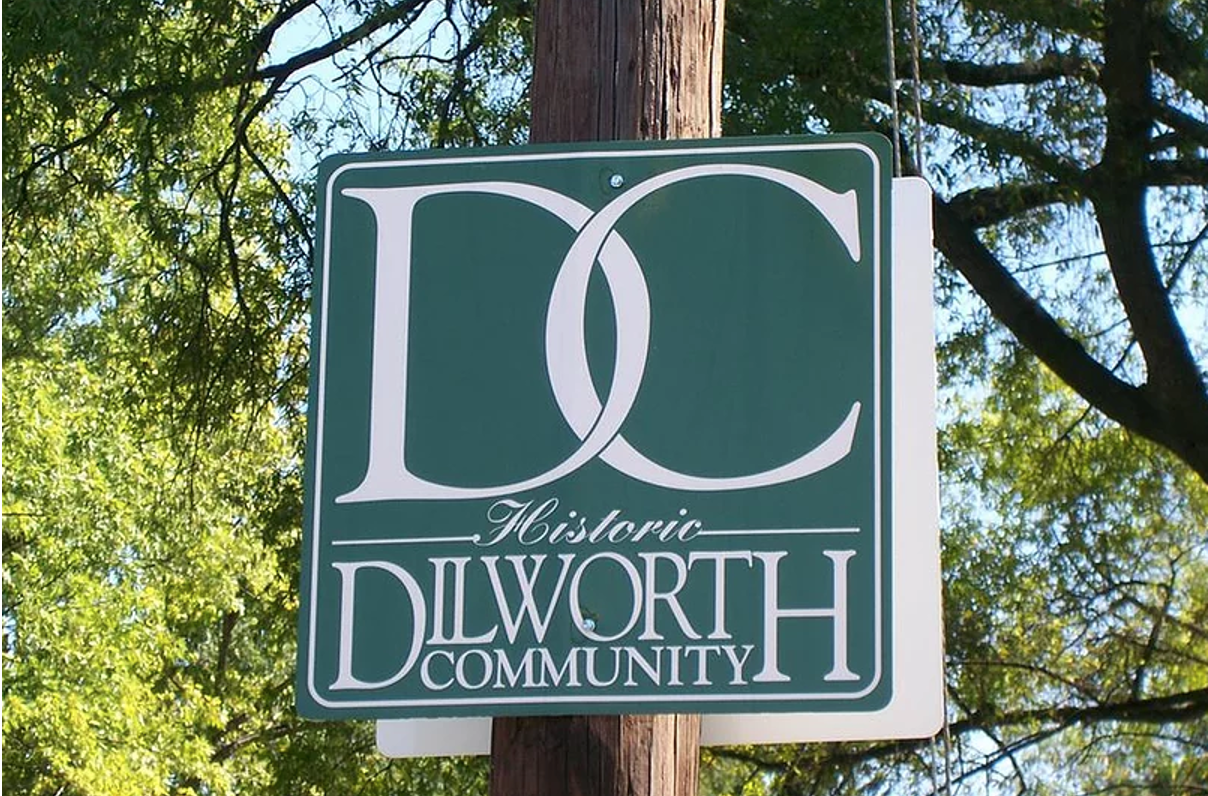
Once you reach the Brem House, below, you’ll be in Charlotte’s official Dilworth Historic District until you come back to South Boulevard.
It’s a big district; there’s another self-guided walk exploring its Dilworth Road/Latta Park area.
Walter Brem house -- 211 East Boulevard
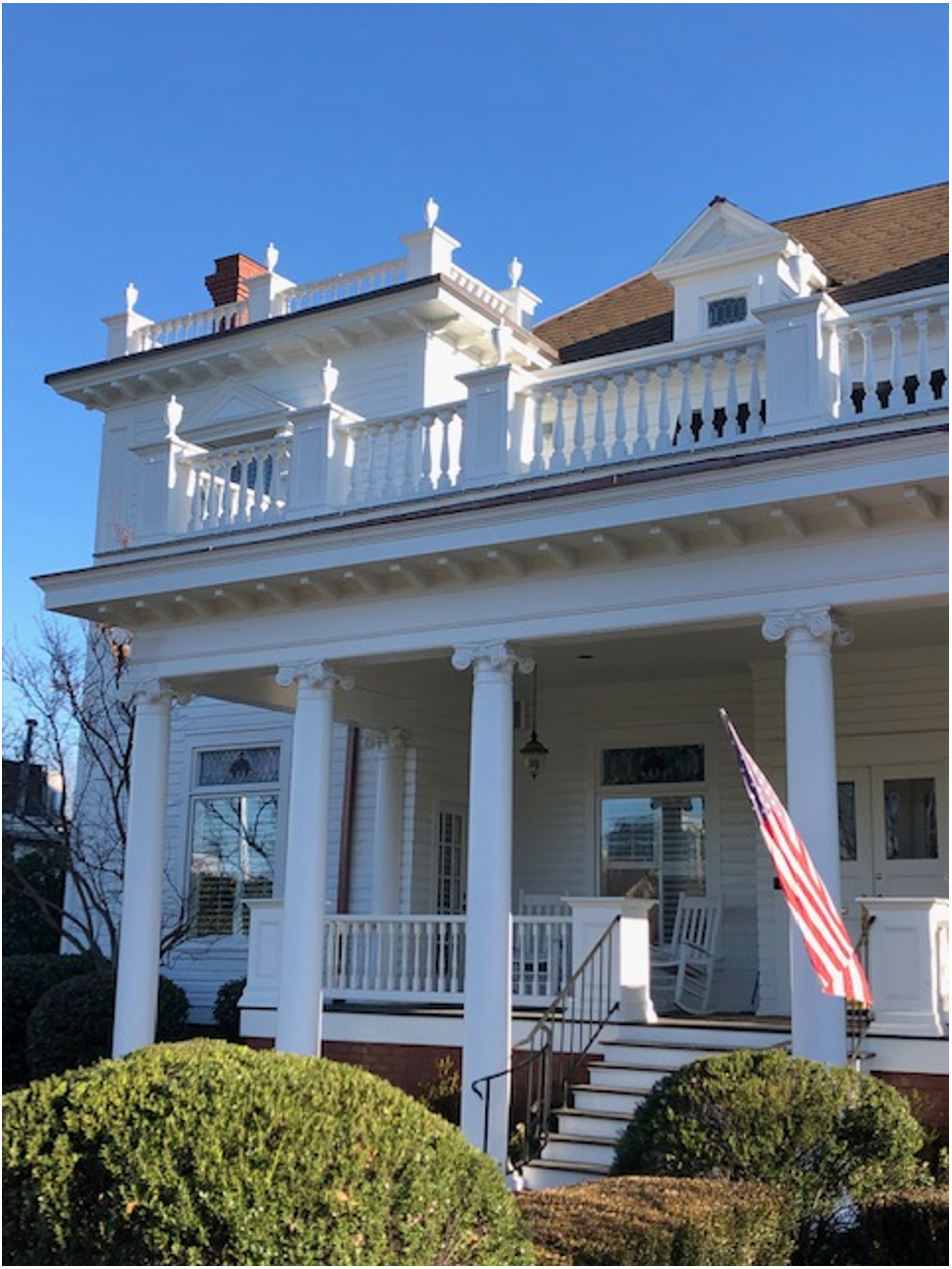
The Walter Brem House is an official Charlotte Mecklenburg Historic Landmark.
Sunflour Bakery – 220 East Boulevard
Paper Skyscraper – 330 East Boulevard
Ready for a break from all this history? Consider a stop at neighborhood favorites Sunflour Bakery or the Paper Skyscraper gift shop.
Crutchfield-Bomar-Brem House -- 307 East Boulevard
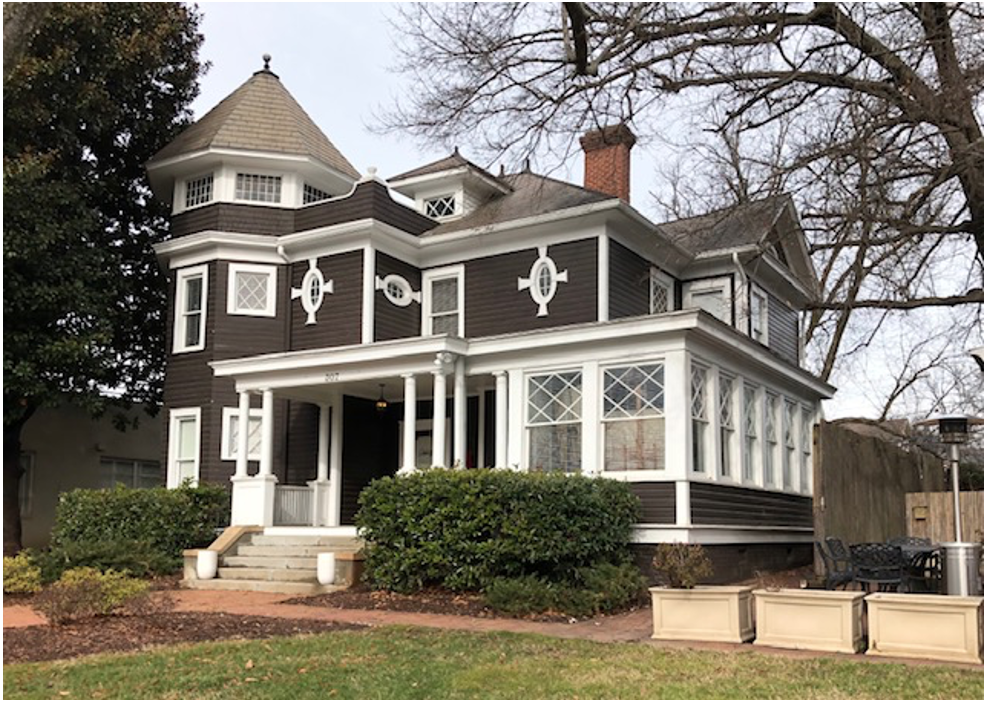
The Crutchfield-Bomar-Brem House is an official Charlotte Mecklenburg Historic Landmark.
Carson McCullers’ boarding house / Copper -- 311 East Boulevard
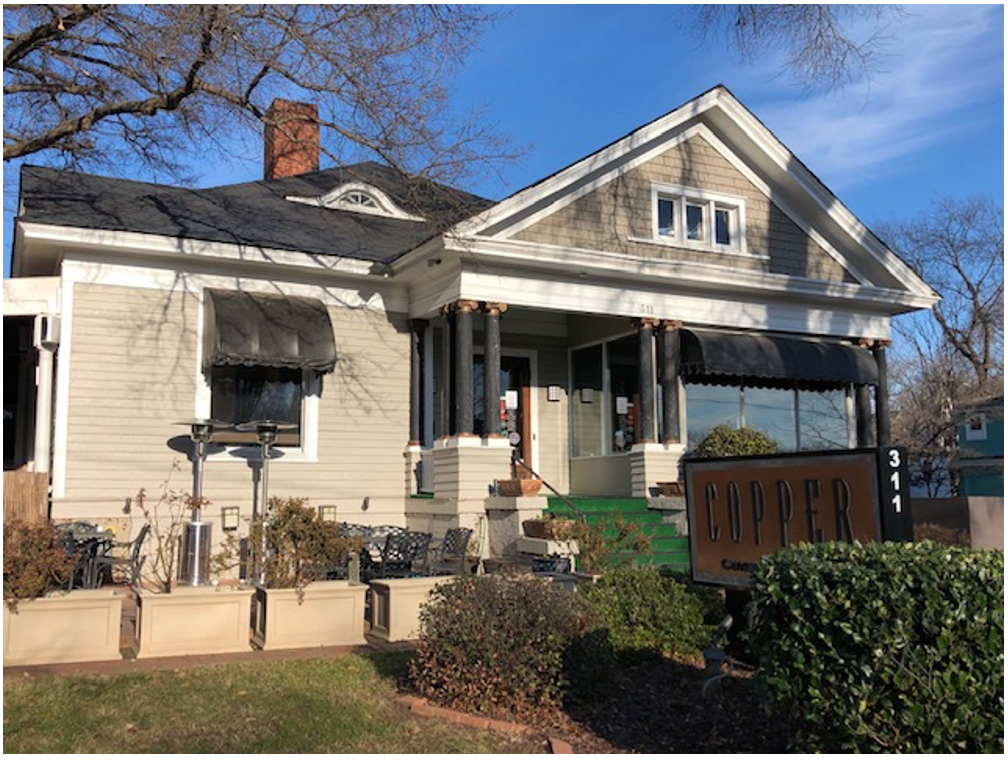
The Mayer House is an official Charlotte Mecklenburg Historic Landmark.
Turn left on Euclid Avenue
Mallonee-Jones House, 400 E Kingston Avenue
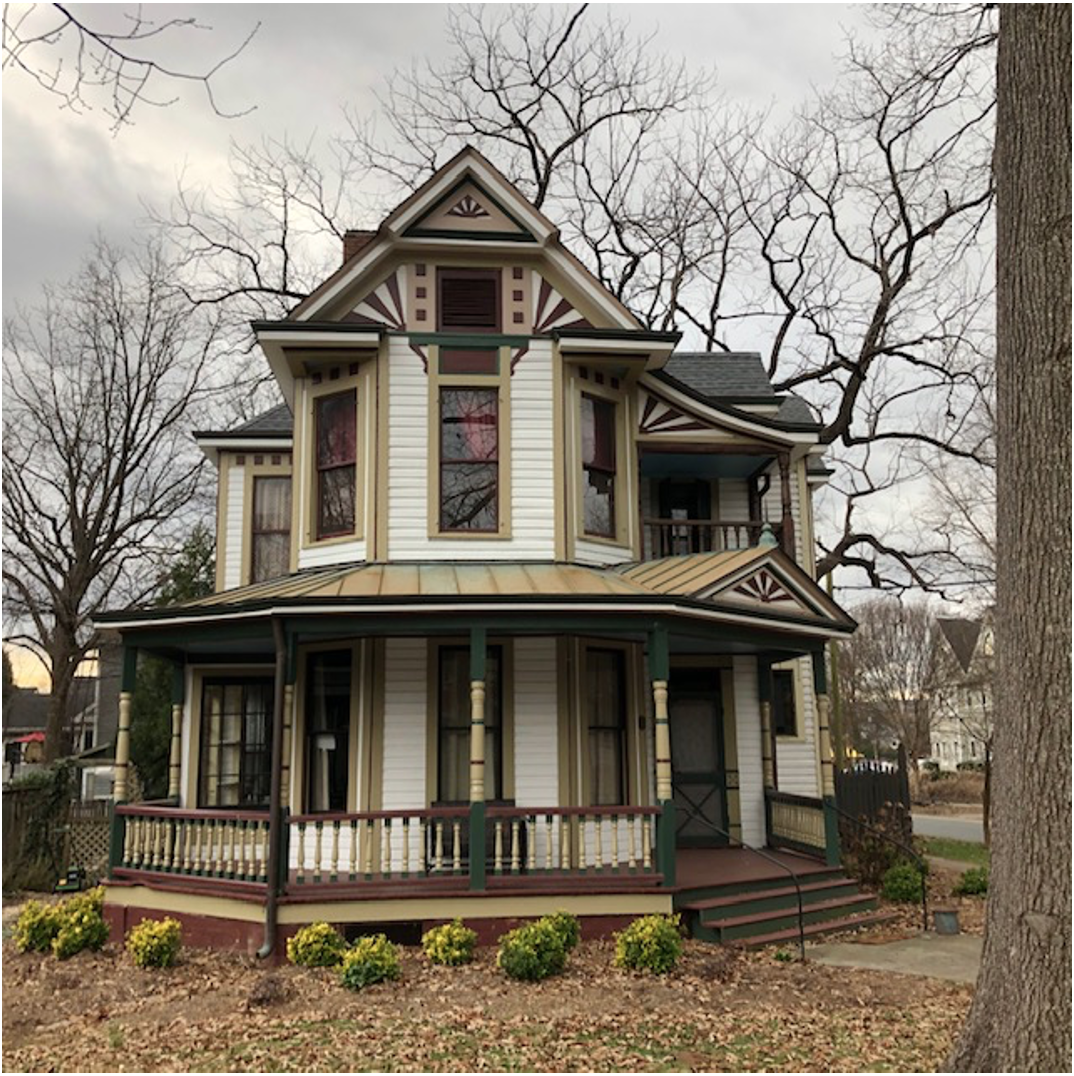
Local attorney Mercer J. Blankenship – the kind of quirky guy who would walk the entire Appalachian Trail after retiring from his law career – worked with Dr. Dan Morrill to get the house designated an official Charlotte Mecklenburg Historic Landmark in 1980, one of the first in Dilworth.
Harrill-Porter House -- 329 E. Kingston Avenue
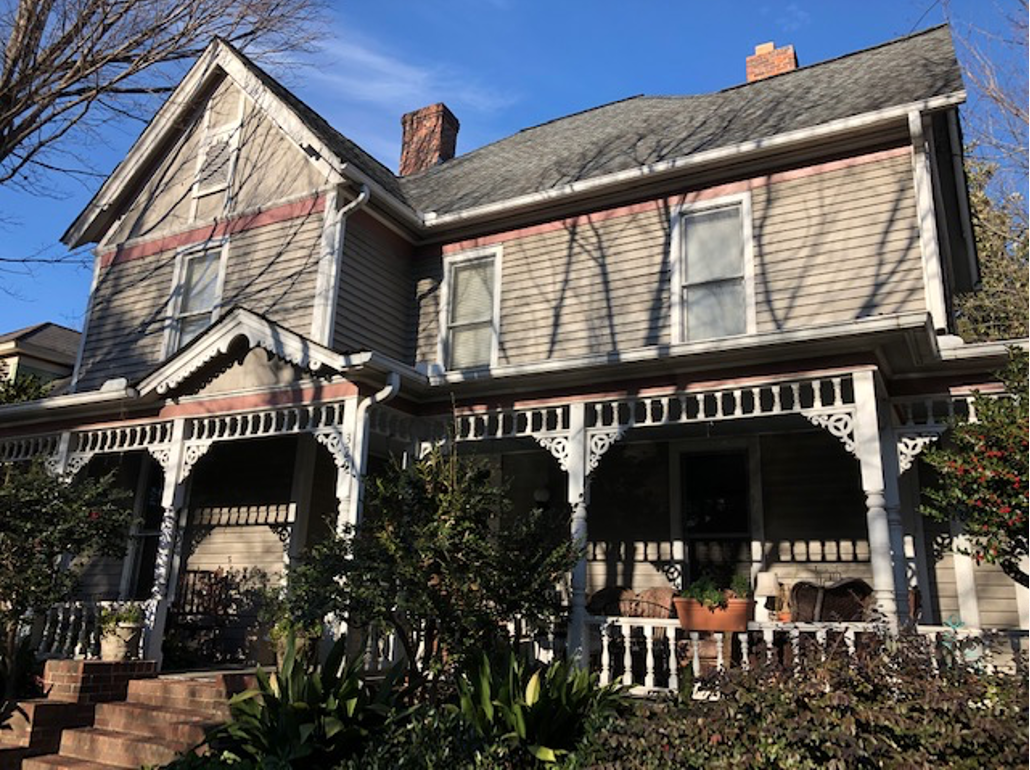
The Harrill-Porter House is an official Charlotte Mecklenburg Historic Landmark.
Turn left on Park Avenue and walk two blocks to South Boulevard.
Robert J. Walker House -- 329 E. Park Avenue
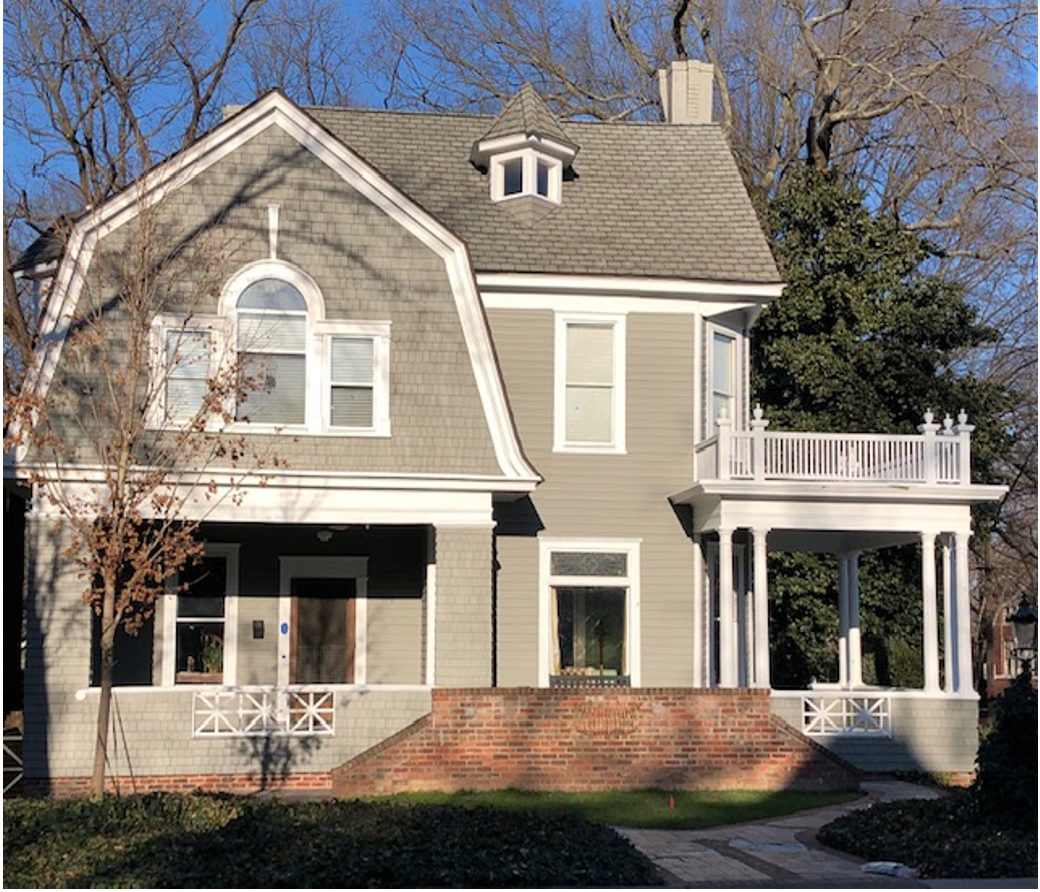
The Walker House is an official Charlotte Mecklenburg Historic Landmark.
Gautier-Gilchrist House -- 320 E. Park Avenue
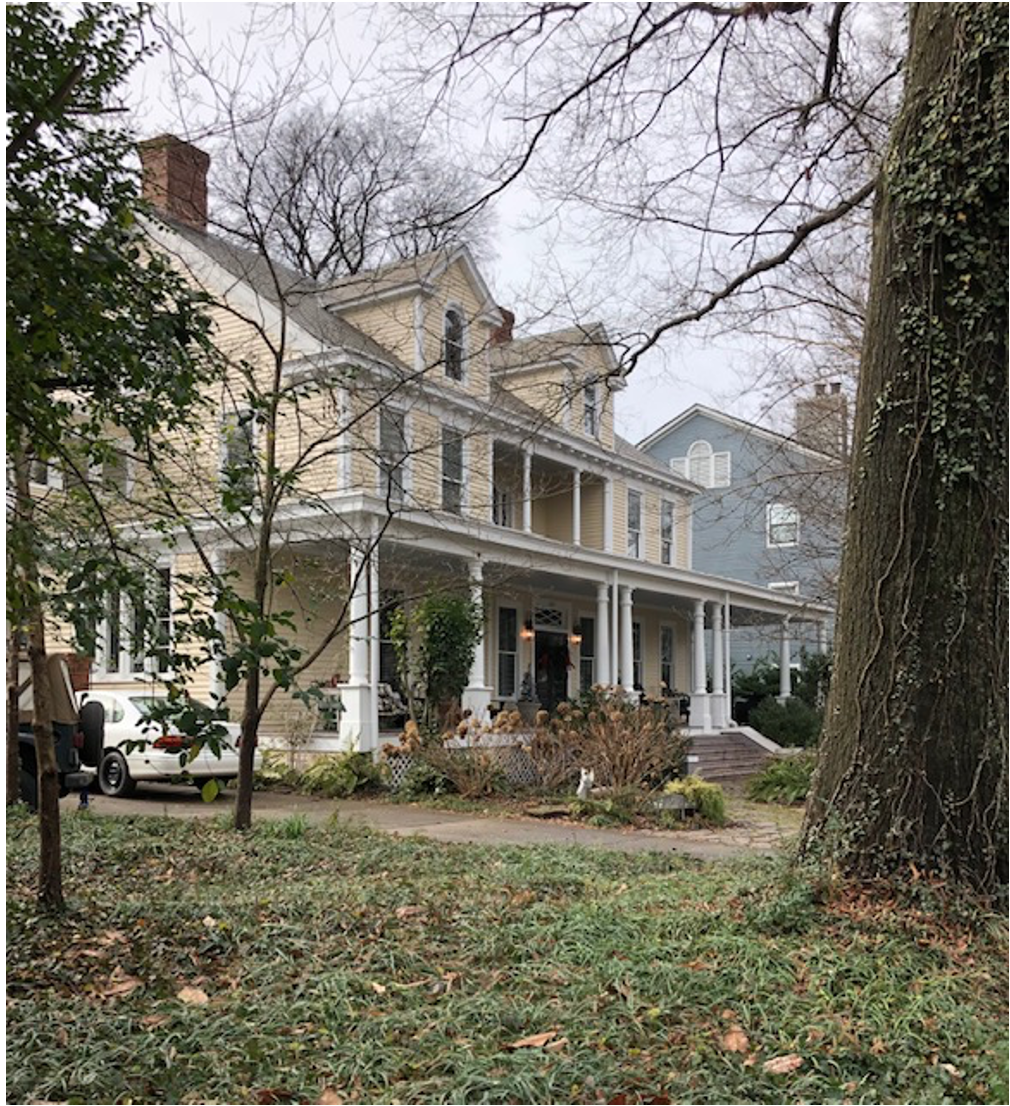
The Gautier-Gilchrist House is an official Charlotte Mecklenburg Historic Landmark.
Villalonga-Alexander House -- 301 E. Park Avenue
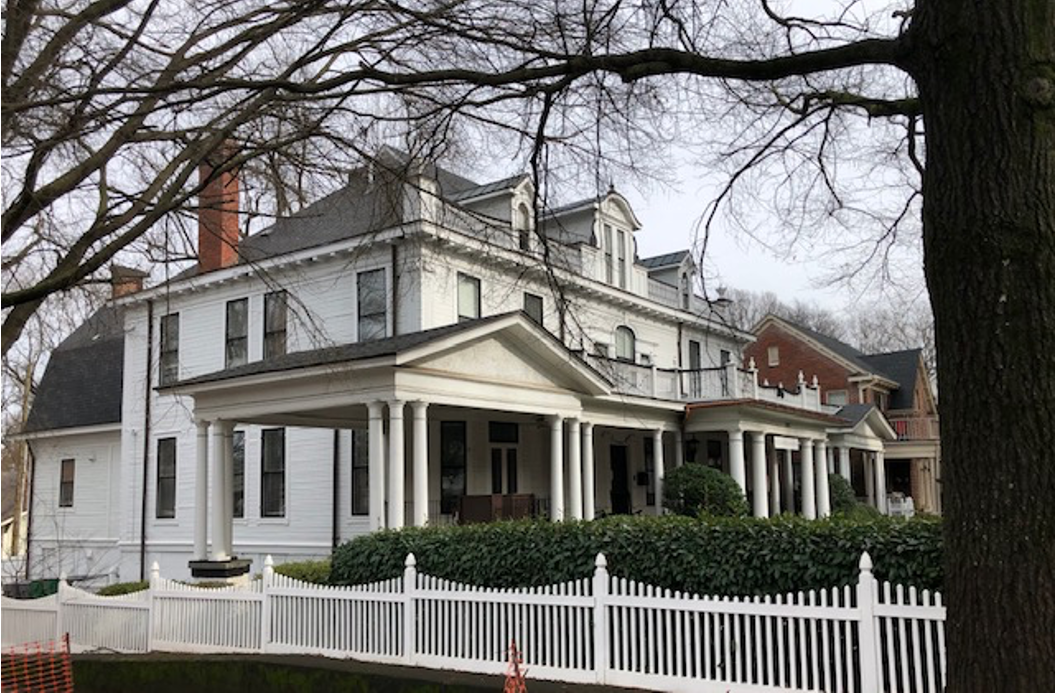
The Villalonga-Alexander House is an official Charlotte Mecklenburg Historic Landmark.
Jones-Garibaldi House -- 228 E Park Avenue

The Jones – Garibaldi House is an official Charlotte Mecklenburg Historic Landmark.
Cross South Boulevard at the traffic light, then turn right on South Boulevard (you’ll be on South Boulevard’s left sidewalk, walking inbound).
Dilworth Drug Store – 1500 South Boulevard
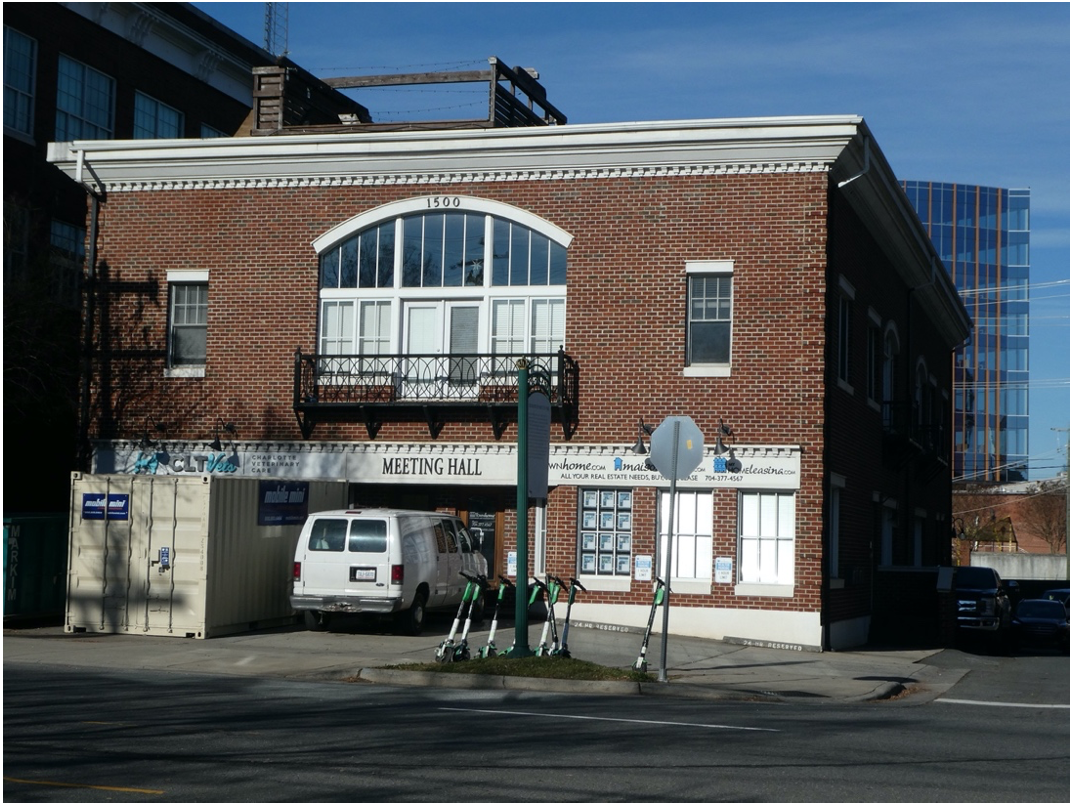
This building, much modified, dates back to 1904 when developer Edward Dilworth Latta had it constructed as drug store, post office and meeting hall serving his new suburb.
By the way, the cross street here, Rensselaer Avenue, likely refers to famed engineering school Rensselaer Polytechnic Institute in New York, where mill man D.A. Tompkins got his education.
Continue walking inbound on South Boulevard.
Trolley Barn and Streetcar Strike – 1400 South Boulevard
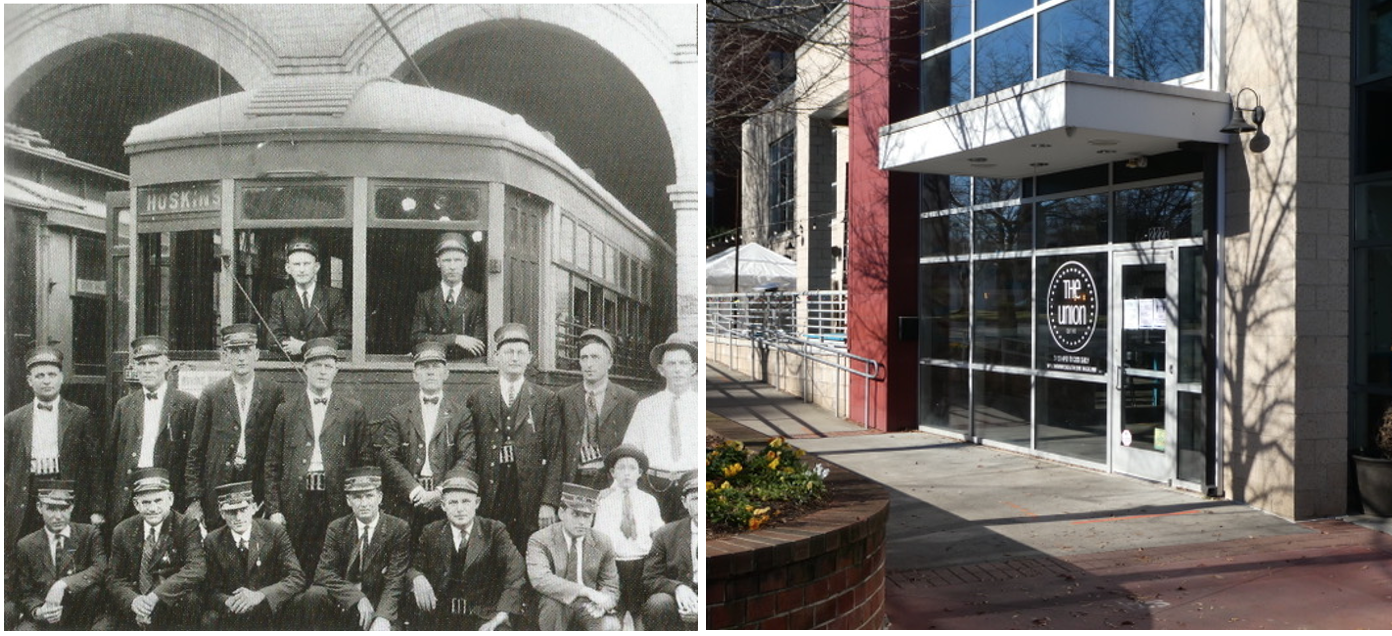
Where The Union Pub is today on South Boulevard at Bland Street once stood the Trolley Barn for Charlotte’s streetcar system. In 1919, the motormen who drove the streetcars went on strike for better pay and union recognition. It did not go well. Five men were killed and fifteen wounded by police, Charlotte’s most violent labor disturbance.
Continue walking inbound on South Boulevard.
Lance plant – 1300 South Boulevard
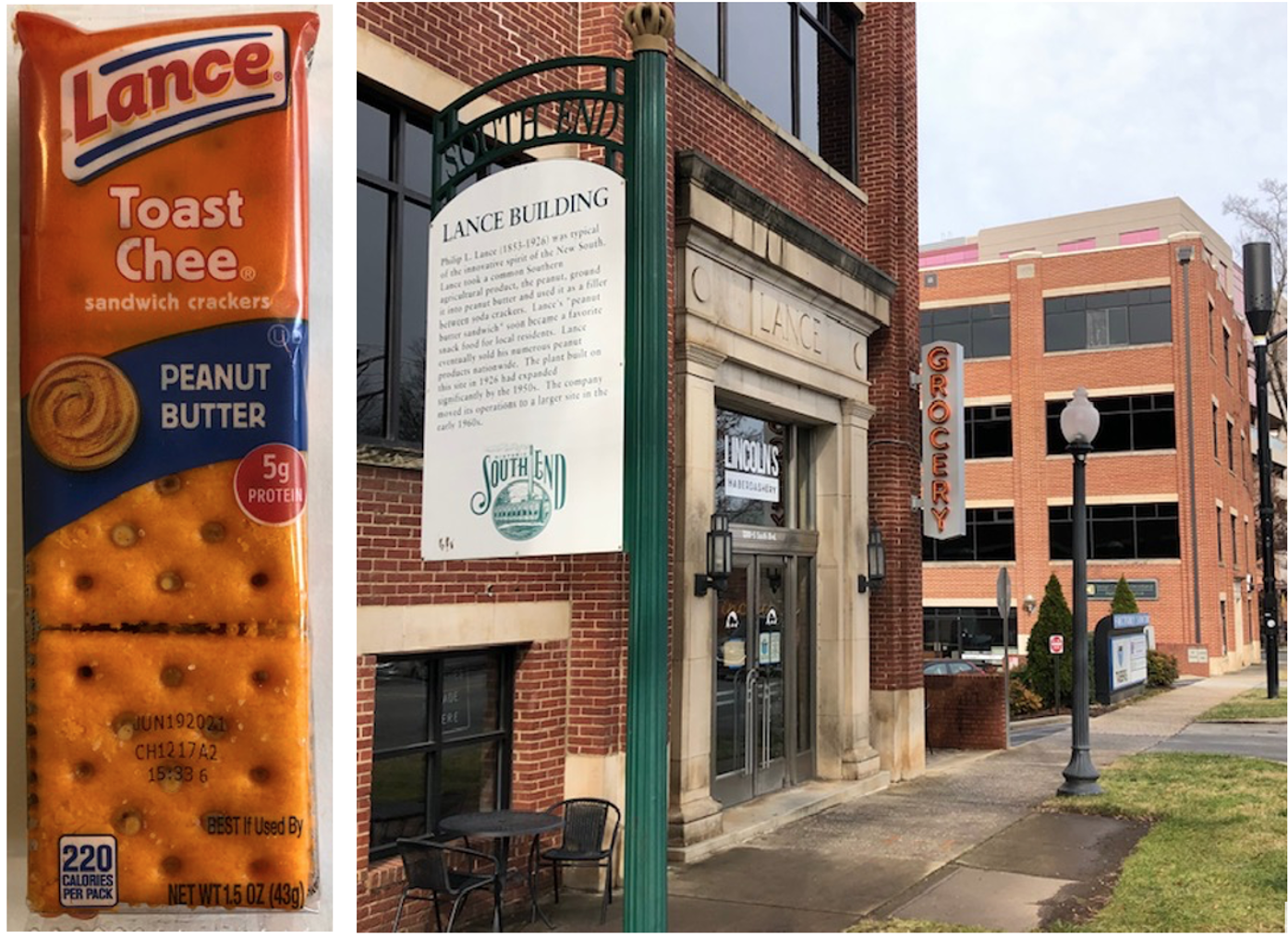
Philip Lance, a coffee bean broker who got stuck with a load of peanuts, discovered a profit in roasting and selling them from a cart at local movie theaters. His daughter Mary Arnold Lance Van Every came up with the notion of putting peanut-butter on crackers, a snack that millworkers could carry in their pockets during long 10-hour shifts. Lance built the left-hand part of this complex in 1926 then doubled it in 1941, before moving to a bigger site far down South Boulevard in 1962. Today Lincoln Haberdashery serves up sandwiches and snacks.
Turn left on Arlington Avenue.
Latta’s pants factory – 310 Arlington Avenue at the LYNX track
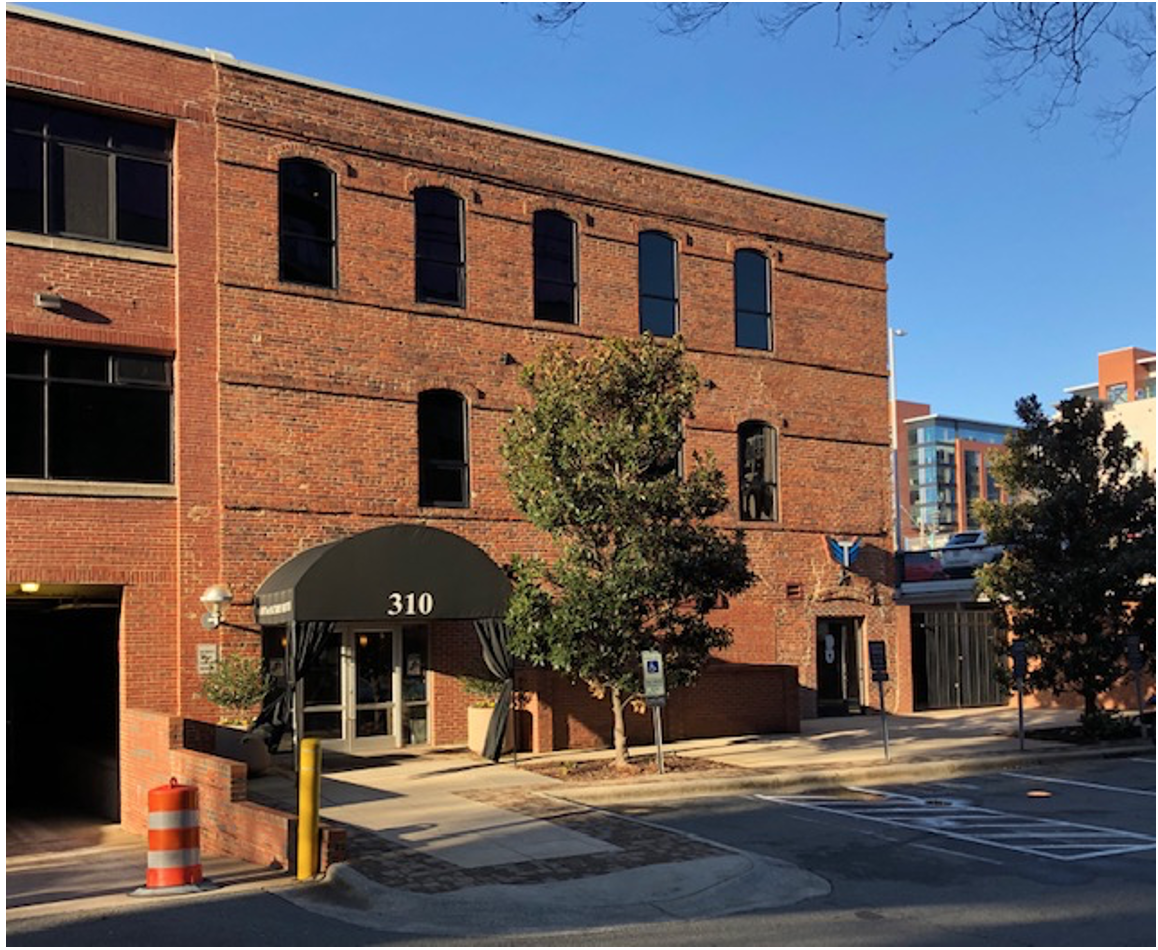
If you are able, climb up the stairs at the end of Arlington Avenue, then turn left on the “rail trail” along the LYNX track.
If stairs aren’t your thing, retrace your steps back to South Boulevard, turn right, then right again on Bland Street – which gets you to the LYNX line, where you’ll turn left.
You can follow the LYNX rail trail all the way back to our starting point. Tired? Buy a ticket, board the train and go one stop to the East-West Station.
Charlotte Exposition Building – 100 E. Park Avenue
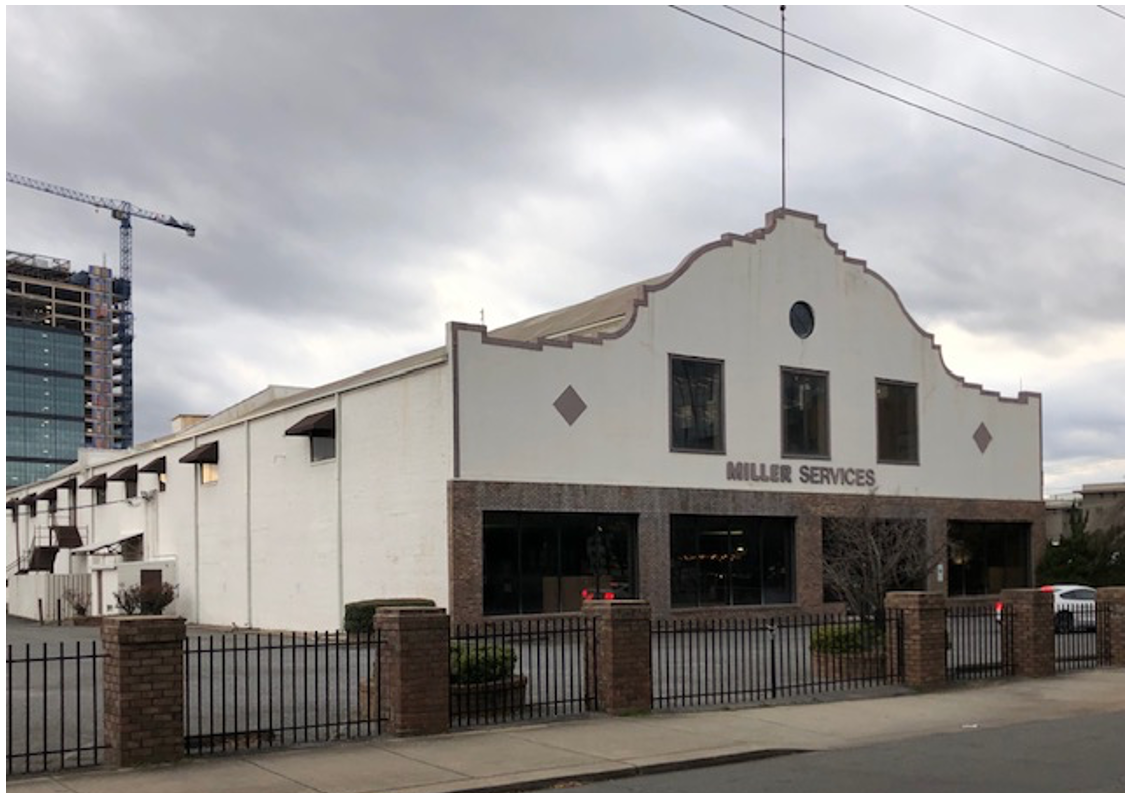
At Park Avenue, you can stay on the rail trail, or bop to your right and get on Camden Road, which runs parallel to the LYNX. This stretch of Camden Road has many places to stop for snacks. We’ll spotlight two, below.
By the way, Camden Road was the main route south out of Charlotte going toward Camden, SC, until South Boulevard supplanted it in the 20th century.
Price’s Chicken Coop – 1614 Camden Road
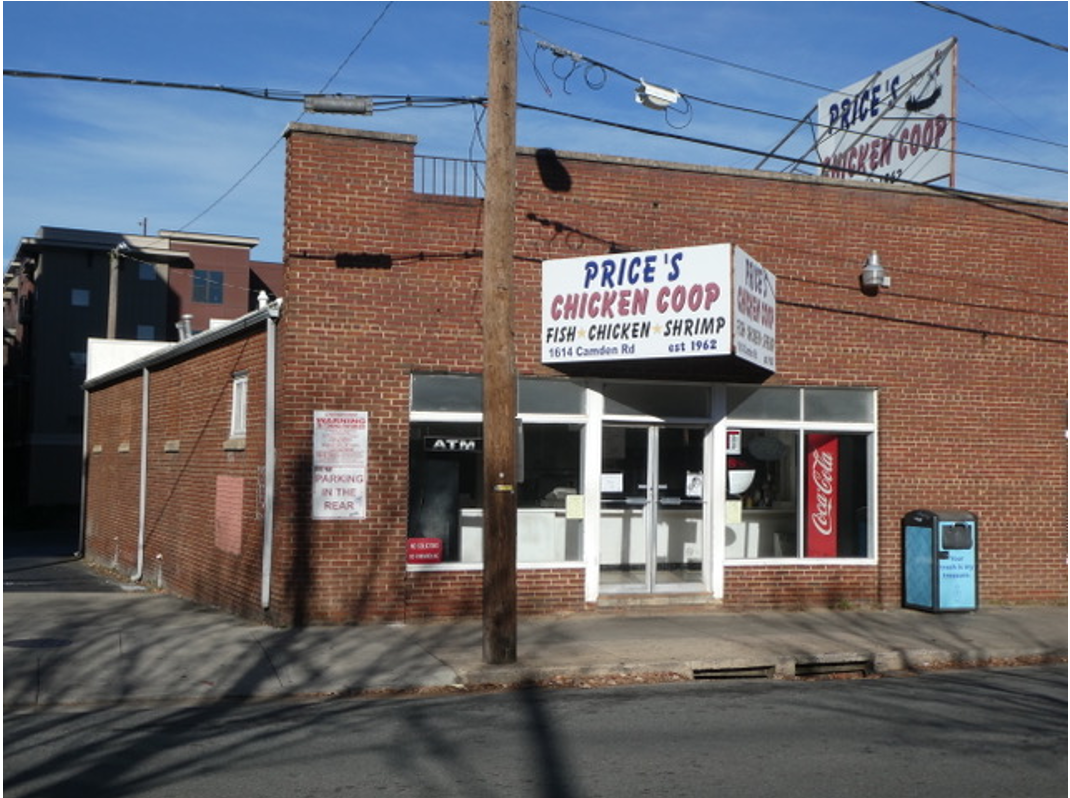
Talmadge Price started selling live chickens back in 1962 when this was a work-a-day industrial district. Laborers pestered him to fry up a few birds for lunch. Today blue-collar and white-collar customers mingle in friendly, fast-moving lines. No seats, so take your bird in its cardboard box over to the grassy embankment across the street. That’s what Tonight Show star Jay Leno did on a 2015 visit.
[Update: Price’s closed June 19, 2021, to great community sadness. A big real estate development is rumored.]
Sabor Latin Street Grill – 1616 Camden Road
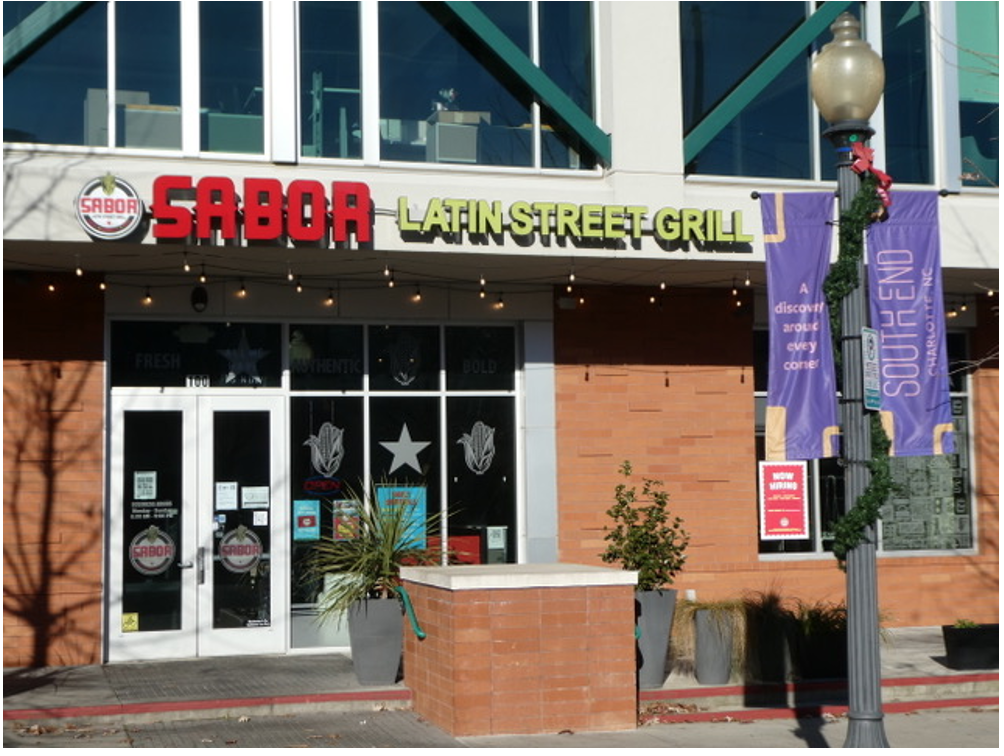
And … you’re back to where our tour began.
Want to learn more?
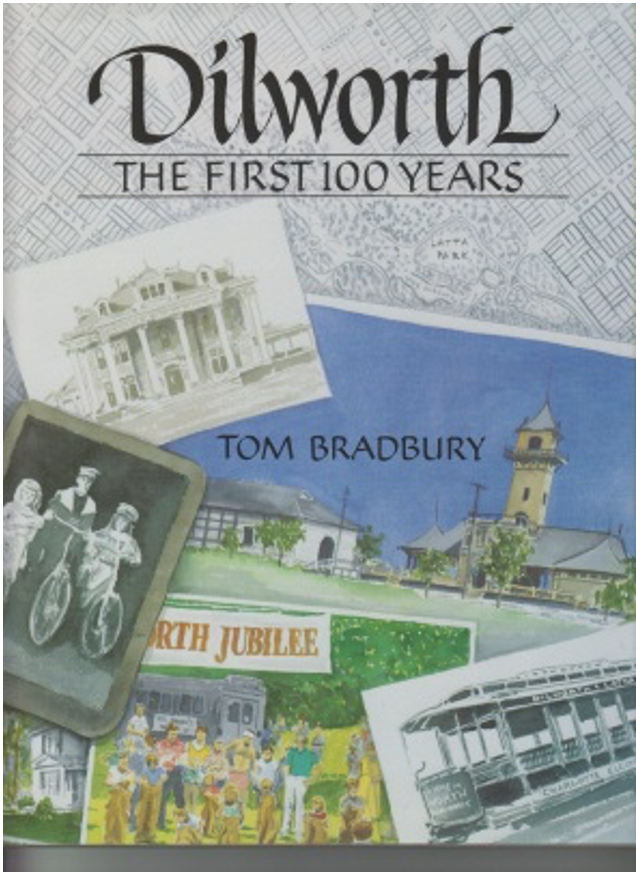
Check out the South End merchants’ group and the Dilworth Community Association.
Tom Bradbury’s book Dilworth: The First 100 Years is at Charlotte Mecklenburg Library and is often for sale at Paper Skyscraper, 330 East Boulevard.
Most of Dilworth’s residential area is an official Charlotte Historic District and is also listed on the National Register of Historic Places. Essays by two local historians trace development of the 1891 section of Dilworth (focus of this tour) and the 1911 Olmsted streets.
Ready to walk some more? Try our tour of the newer section of Dilworth.
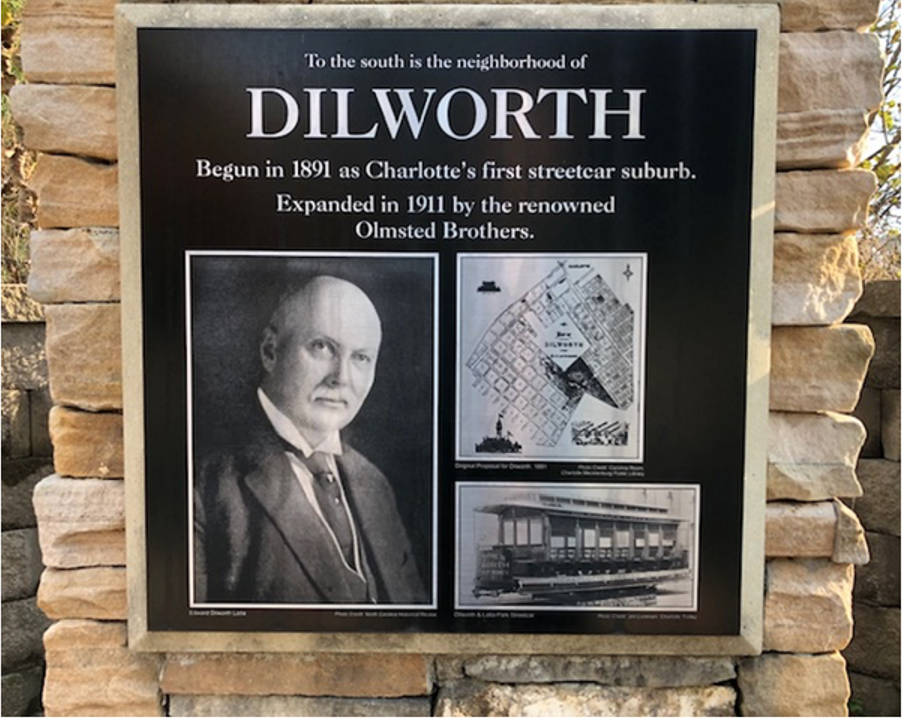
Our Charlotte Walking Tours
Some other tours we like
Mid-Century Modern in Center City
ArtWalks Charlotte – self guided walking tours of murals and other public art
Sorting Out the New South City explores how Charlotte became a city of neighborhoods. Book discussion guide available here >>

 Historic Plaza Midwood
Historic Plaza Midwood